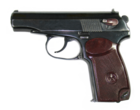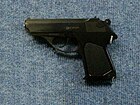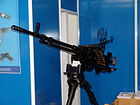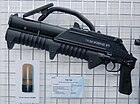Mongolian Ground Force
This article needs additional citations for verification. (October 2013) |
| Mongolian General Purpose Force Монгол Улсын Ерөнхий Цэргийн Хүчин | |
|---|---|
 Mongol tug in Sukhbaatar Square. | |
| Active | 1992 – present |
| Country | |
| Allegiance | Ministry of Defence |
| Type | Army |
| Size | 8,900 active personnel[1] |
| Part of | Mongolian Armed Forces |
General Purpose Force of the Mongolians (Mongolian: Монгол Улсын Ерөнхий Цэргийн Хүчин, Mongol Ulsyn Eronhii Tsergiin Hüchin) is the land force of the Armed Forces of the Mongolia, formed from parts of the former Mongolian People's Army in 1992.
History


At present Mongolia's armed forces have become more compact and professional since obligatory military service was replaced with the alternative between military and other service. The general purpose troops, a core of the armed forces, are the main force to defend the country by military means. In peacetime, the general purpose troops direct their activities toward ensuring the mobilization readiness of the Mongolian Armed Forces, providing military training for the population, forming personnel resources, and organizing the maintenance, protection and servicing of military equipment and material reserves. Depending on the organizational specifics of military units and organizations, the general purpose troops are divided into combat, on-combat-duty, training, training combat, and stockpile and service units.
As a result of reform processes started in 1997, main units of the Mongolian Armed Forces were reorganized into brigades. In peacetime, sub-units of brigades have a mixed personnel organization, i.e. of constant combat readiness, training, and under strength. At present, the general purpose troops of the armed forces comprise motor rifle brigades, artillery brigade, independent motor rifle battalion, independent combat aircraft unit and other combat and combat supply and service units.
The 016 Mechanised Brigade has been reported as the oldest formation of the Mongolian army, stationed at Sergelene near Ulan Bator.[2]
In 1997 the Mongolian Armed Forces had in service 650 tanks, 120 light armored reconnaissance vehicles, 400 armored infantry fighting vehicles, 300 armored personnel carriers, 300 towed artillery, 130 multiple rocket launchers, 140 mortars, and 200 anti-tank guns.
Mongolia deployed its troops to peacekeeping operations in Iraq and Afghanistan with 1970’s Soviet style of weapons, transportation, and equipment. Although Mongolian troops are highly skilled on that weapon and equipment, they are not interoperable with the rest of the coalition members. Except for the United States provided Harris Corporation communications equipment, Mongolia had no other equipment which was interoperable.
On January 14–18, 2008, Chief of the General Staff of the MAF Lieutenant General Tsevegsuren Togoo signed an agreement for acquisition of equipment and vehicles from Russia for 120 million US dollars during his official visit to Moscow, Russia.
Peacekeeping missions

Mongolian armed forces are performing peacekeeping missions in South Sudan, Sierra Leone, Ethiopia, Congo, Eritrea, Western Sahara and Afghanistan, and with the United Nations Mission in Liberia. In 2005/2006, Mongolian troops also served as part of the Belgian KFOR contingent in Kosovo. From 2009 Mongolian Armed Forces deploying its largest peace keeping mission to Chad and the government is planning to deploy its first fully self-sufficient UN mission there in mid-2011.
On November 17, 2009, Deputy Assistant Secretary of Defense for Partnership Strategy and Stability Operations, James Schear had lunch with Colonel Ontsgoibayar and selected troops from the 150th Peacekeeping Battalion under his command, bound for Chad on November 20, 2009.[3] Afterwards Schear visited the Five Hills Regional Training Center, which hosts numerous combined multinational training opportunities for peacekeepers.
Capability









The Ground Forces possess over 470 tanks, 650 Infantry Fighting Vehicles and armored personnel carriers, 500 mobile anti-aircraft weapons, more than 700 artillery and mortar and other military equipment. Most of them are old Soviet Union models designed between the late 1950s to early 1980s. There are a smaller number of newer models designed in post-Soviet Russia.
Infantry Weapons
References
- ^ The Military Balance 2013
- ^ "The Mongolian army was T-72 tanks and BTR-70M". Encyclopedia of safety. Retrieved June 20, 2016.
- ^ "Cable 09ULAANBAATAR332 (unredacted)". cabledrum.net. November 18, 2009. Retrieved June 20, 2016.
- ^ a b c d e f g h The Military Balance 2012, p.267.
- ^ a b c bmpd (September 23, 2012). "Монгольская армия получает танки Т-72 и БТР-70М". livejournal.com (in Russian). Retrieved June 20, 2016.
{{cite web}}: Unknown parameter|trans_title=ignored (|trans-title=suggested) (help) - ^ http://bmpd.livejournal.com/1694496.html
- ^ a b c d "SIPRI Arms Transfers Database". Stockholm International Peace Research Institute. Retrieved June 20, 2016.
- ^ bmpd (January 23, 2016). "Передача Монголии новой партии российской боевой техники". livejournal.com (in Russian). Retrieved June 20, 2016.
{{cite web}}: Unknown parameter|trans_title=ignored (|trans-title=suggested) (help) - ^ "БХ-ын сайд тайлангаа тавив". News.mn (in Mongolian). May 3, 2011. Retrieved June 20, 2016.
- ^ a b c d e f g h i j k Jones, Richard D., ed. (January 27, 2009). Jane's Infantry Weapons 2009/2010 (35th ed.). Jane's Information Group. ISBN 978-0-7106-2869-5.
- ^ "084.jpg". ImageShack.us. Retrieved June 20, 2016.
- ^ Тусгай Хүчин (December 28, 2013). "Mongolian 084th Special Task Battalion". Retrieved June 20, 2016 – via YouTube.
- ^ "zql6.jpg". ImageShack.us. Retrieved June 20, 2016.
- ^ "Untitled JPEG". National Geographic. Archived from the original on November 12, 2014. Retrieved June 20, 2016.
- ^ "Untitled JPEG". Shuud.mn. 2011. Retrieved June 20, 2016.
- ^ Ankhbayar Danuu (December 1, 2011). "084th division. Mongolian special task battalion". Retrieved June 20, 2016 – via YouTube.
- ^ http://www.defenseimagery.mil/imagery.html;jsessionid=717EA410EC7024DF88659819C061B880#guid=d9aa514e67a1ca4557f7bb646b8488217f594dd5 [dead link]
- ^ RabidWombatz (April 14, 2013). "Ulaanbaatar Mongolia Russian Machine Gun RPD at shooting range". Retrieved June 20, 2016 – via YouTube.
- ^ "Mongolian Military Museum". Legend Tour. Archived from the original on November 6, 2013. Retrieved June 20, 2016.
- ^ "Untitled JPEG". U.S Department of Defense. January 2004. Archived from the original on October 11, 2014. Retrieved 20 June 2016.
- ^ "SVD rifles in use in Europe". Dragunov.net. Archived from the original on November 9, 2012. Retrieved June 20, 2016.
- ^ a b "Unititled JPEG". ImageShack.us. Archived from the original on July 2, 2014. Retrieved June 20, 2016.
- ^ a b "Unititled JPEG". ImageShack.us. Archived from the original on December 7, 2013. Retrieved June 20, 2016.
 This article incorporates public domain material from The World Factbook. CIA.
This article incorporates public domain material from The World Factbook. CIA.- World aircraft information files Bright Star Publishing London File 332 Sheet 3






















